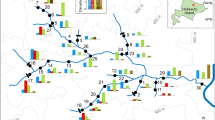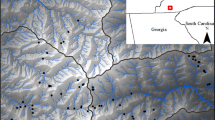Abstract
Theory suggests that source–sink dynamics can allow coexistence of intraguild predators and prey, but empirical evidence for this coexistence mechanism is limited. We used capture–mark–recapture, genetic methods, and stable isotopes to test whether source–sink dynamics promote coexistence between stream fishes, the intraguild predator, and stream salamanders (Dicamptodon aterrimus), the intraguild prey. Salamander populations from upstream reaches without fish were predicted to maintain or supplement sink populations in downstream reaches with fish. We found instead that downstream reaches with fish were not sinks even though fish consumed salamander larvae—apparent survival, recruitment, and population growth rate did not differ between upstream and downstream reaches. There was also no difference between upstream and downstream reaches in net emigration. We did find that D. aterrimus moved frequently along streams, but believe that this is a response to seasonal habitat changes rather than intraguild predation. Our study provides empirical evidence that local-scale mechanisms are more important than dispersal dynamics to coexistence of streams salamanders and fish. More broadly, it shows the value of empirical data on dispersal and gene flow for distinguishing between local and spatial mechanisms of coexistence.



Similar content being viewed by others
References
Amarasekare P (2000) Coexistence of competing parasitoids on a patchily distributed host: local vs. spatial mechanisms. Ecology 81:1286–1296
Amarasekare P (2003) Competitive coexistence in spatially structured environments: a synthesis. Ecol Lett 6:1109–1122
Amarasekare P (2006) Productivity, dispersal and the coexistence of intraguild predators and prey. J Theor Biol 243:121–133
Amarasekare P, Nisbet R (2001) Spatial heterogeneity, source–sink dynamics, and the local coexistence of competing species. Am Nat 158:572–584
Arim M, Marquet P (2004) Intraguild predation: a widespread interaction related to species biology. Ecol Lett 7:557–564
Barbour RW, Hardin JW, Schafer JP, Harvey MJ (1969) Home range, movements, and activity of the dusky salamander, Desmognathus fuscus. Copeia 2:293–297
Barr G, Babbitt K (2007) Trout affect the density, activity and feeding of a larval plethodontid salamander. Freshwat Biol 52:1239–1248
Benstead JP, March JG, Fry B, Ewel KC, Pringle CM (2006) Testing IsoSource: stable isotope analysis of a tropical fishery with diverse organic matter sources. Ecology 87:326–333
Brodie ED, Formanowicz DR (1987) Antipredator mechanisms of larval anurans: protection of palatable individuals. Herpetologica 43:369–373
Bruce RC (1986) Upstream and downstream movements of Eurycea bislineata and other salamanders in a southern Appalachian stream. Herpetologica 42:149–155
Burnham KP, Anderson DR (2002) Model selection and multimodel inference: a practical information-theoretic approach. Springer, Berlin
Cecala KK, Price SJ, Dorcas ME (2009) Evaluating existing movement hypotheses in linear systems using larval stream salamanders. Can J Zool 87:292–298
Choquet R, Reboulet AM, Lebreton JD, Gimenez O, Pradel R (2005) U-CARE 2.2 User’s manual. CEFE, UMR 5175. CNRS, Montpellier
Curtis JM, Taylor EB (2000) Isolation and characterization of microsatellite loci in the Pacific Giant salamander Dicamptodon tenebrosus. Mol Ecol 9:116–118
Davic RD, Welsh HH (2004) On the ecological roles of salamanders. Annu Rev Ecol Evol Syst 35:405–434
Decottignies P, Beninger PG, Rincé Y, Robins RJ, Riera P (2007) Exploitation of natural food sources by two sympatric, invasive suspension-feeders: Crassostrea gigas and Crepidula fornicata. Mar Ecol Prog Ser 334:179–192
Diffendorfer JE (1998) Testing models of source–sink dynamics and balanced dispersal. Oikos 81:417–433
Ferguson HM (1998) Demography, dispersal and colonisation of larvae of Pacific giant salamanders (Dicamptodon tenebrosus) at the northern extent of their range. MSc thesis, University of British Columbia, Vancouver
Grant EHC (2008) Visual implant elastomer mark retention through metamorphosis in amphibian larvae. J Wildl Manag 72:1247–1252
Grant EHC, Lowe WH, Fagan WF (2007) Living in the branches: population dynamics and ecological processes in dendritic networks. Ecol Lett 10:165–175
Grant EHC, Nichols JD, Lowe WH, Fagan WF (2010) Use of multiple dispersal pathways facilitates amphibian persistence in stream networks. Proc Natl Acad Sci USA 107:6936–6940
Holt RD (1985) Population dynamics in two-patch environments: some anomalous consequences of an optimal habitat distribution. Theor Popul Biol 28:181–208
Holt RD, Polis GA (1997) A theoretical framework for intraguild predation. Am Nat 149:745
Huang C, Sih A (1991) Experimental studies on direct and indirect interactions in a three trophic-level stream system. Oecologia 85:530–536
Kareiva P (1983) Local movement in herbivorous insects: applying a passive diffusion model to mark–recapture field experiments. Oecologia 57:322–327
Koenig WD, Van Vuren D, Hooge PN (1996) Detectability, philopatry, and the distribution of dispersal distances in vertebrates. Trends Ecol Evol 11:514–517
Lebreton JD, Burnham KP, Clobert J, Anderson DR (1992) Modeling survival and testing biological hypotheses using marked animals: a unified approach with case studies. Ecol Monogr 62:67–118
Lowe WH (2003) Linking dispersal to local population dynamics: a case study using a headwater salamander system. Ecology 84:2145–2154
Lowe WH (2009) What drives long-distance dispersal? A test of theoretical predictions. Ecology 90:1456–1462
Lowe WH, Allendorf FW (2010) What can genetics tell us about population connectivity? Mol Ecol 19:3038–3051
Lowe WH, Likens GE, McPeek MA, Buso DC (2006) Linking direct and indirect data on dispersal: isolation by slope in a headwater stream salamander. Ecology 87:334–339
Manel S, Gaggiotti OE, Waples RS (2005) Assignment methods: matching biological questions with appropriate techniques. Trends Ecol Evol 20:136–142
Mouquet N, Loreau M (2002) Coexistence in metacommunities: the regional similarity hypothesis. Am Nat 159:420–426
Mullen LB, Woods HA, Schwartz MK, Sepulveda AJ, Lowe WH (2010) Scale-dependent genetic structure of the Idaho giant salamander (Dicamptodon aterrimus) in stream networks. Mol Ecol 19:898–909
Navarrete SA, Menge BA, Daley BA (2000) Species interactions in intertidal food webs: prey or predation regulation of intermediate predators? Ecology 81:2264–2277
Nussbaum RA, Tait CK (1977) Aspects of the life history and ecology of the Olympic salamander, Rhyacotriton olympicus (Gaige). Am Midl Nat 98:176–199
Parker MS (1991) Relationship between cover availability and larval Pacific giant salamander density. J Herpetol 25:355–357
Parker MS (1994) Feeding ecology of stream-dwelling Pacific giant salamander larvae (Dicamptodon tenebrosus). Copeia 1994:705–718
Peery MZ, Becker BH, Beissinger SR (2006) Combining demographic and count-based approaches to identify source–sink dynamics of a threatened seabird. Ecol Appl 16:1516–1528
Petranka JW (1983) Fish predation: a factor affecting the spatial distribution of a stream-breeding salamander. Copeia 1983:624–628
Phillips DL, Gregg JW (2003) Source partitioning using stable isotopes: coping with too many sources. Oecologia 136:261–269
Piry S, Alapetite A, Cornuet J-M, Paetkau D, Baudouin L, Estoup A (2004) GeneClass2: a software for genetic assignment and first-generation migrant detection. J Heredity 95:536–539
Polis GA, Myers CA, Holt RD (1989) The ecology and evolution of intraguild predation: potential competitors that eat each other. Annu Rev Ecol Syst 20:297–330
Pollock KH (1982) A capture-recapture design robust to unequal probability of capture. J Wildl Manag 46:752–757
Pollock KH, Otto MC (1983) Robust estimation of population size in closed animal populations from capture-recapture experiments. Biometrics 39:1035–1049
Post DM (2002) Using stable isotopes to estimate trophic position: models, methods, and assumptions. Ecology 83:703–718
Pradel R (1996) Utilization of capture–mark–recapture for the study of recruitment and population growth rate. Biometrics 52:703–709
Pulliam HR (1988) Sources, sinks, and population regulation. Am Nat 132:652
Rannala B, Mountain JL (1997) Detecting immigration by using multilocus genotypes. Proc Nat Acad Sci USA 94:9197–9201
Raymond M, Rousset F (1995) GENEPOP (version 1.2): population genetics software for exact tests and ecumenicism. J Hered 86:248–249
Resetarits WJ (1991) Ecological interactions among predators in experimental stream communities. Ecology 72:1782–1793
Resetarits WJ (1995) Competitive asymmetry and coexistence in size-structured populations of brook trout and spring salamanders. Oikos 73:188–198
Rice WR (1989) Analyzing tables of statistical tests. Evolution 43:223–225
Rundio DE, Olson DH (2003) Antipredator defenses of larval Pacific giant salamanders (Dicamptodon tenebrosus) against cutthroat trout (Oncorhynchus clarki). Copeia 2003:402–407
Runge JP, Runge MC, Nichols JD (2006) The role of local populations within a landscape context: defining and classifying sources and sinks. Am Nat 167:925–938
Sepulveda AJ, Lowe WH (2009) Local and landscape-scale influences on the occurrence and density of Dicamptodon aterrimus, the Idaho giant salamander. J Herpetol 43:469–484
Sepulveda AJ, Colyer WT, Lowe WH, Vinson MR (2009) Using nitrogen stable isotopes to detect long-distance movement in a threatened cutthroat trout (Oncorhynchus clarkii utah). Can J Fish Aquat Sci 66:672–682
Sih A, Kats LB, Moore RD (1992) Effects of predatory sunfish on the density, drift, and refuge use of stream salamander larvae. Ecology 73:1418–1430
Simon KS, Benfield EF, Macko SA (2003) Food web structure and the role of epilithic biofilms in cave streams. Ecology 84:2395–2406
Spruell P, Rieman BE, Knudsen KL, Utter FM, Allendorf FW (1999) Genetic population structure within streams: microsatellite analysis of bull trout populations. Ecol Freshwat Fish 8:114–121
Stebbins RC (2003) A field guide to western reptiles and amphibians. Houghton Mifflin, New York
Steele CA, Baumsteiger J, Storfer A (2008) Polymorphic tetranucleotide microsatellites for Cope’s giant salamander (Dicamptodon copei) and Pacific giant salamander (Dicamptodon tenebrosus). Mol Ecol 8:1071–1073
Storfer A, Sih A (1998) Gene flow and ineffective antipredator behavior in a stream-breeding salamander. Evolution 52:558–565
Thiesmeier B, Schuhmacher H (1990) Causes of larval drift of the fire salamander, Salamandra salamandra terrestris, and its effects on population dynamics. Oecologia 82:259–263
Van Buskirk J, Schmidt BR (2000) Predator-induced phenotypic plasticity in larval newts: trade-offs, selection, and variation in nature. Ecology 81:3009–3028
Werner EE (1977) Species packing and niche complementarity in three sunfishes. Am Nat 111:553–578
Werner EE, Gilliam JF (1984) The ontogenetic niche and species interactions in size-structured populations. Annu Rev Ecol Syst 15:393–425
White GC, Burnham KP (1999) Program MARK: survival estimation from populations of marked animals. Bird Study 46:120–138
Wright S (1951) The genetical structure of natural populations. Ann Eugen 15:323–354
Zar JH (1984) Biostatistical analysis. Prentice-Hall, Englewood Cliffs
Acknowledgments
This research was funded by grants from the Society for Northwestern Vertebrate Biology, Charlotte Martin Foundation, the Pacific Rivers Council, USGS Montana River Center, and the University of Montana. We thank Peter Marra of the Smithsonian OUSS/MCI Stable Isotope Mass Spectrometry Facility for assistance with sample analysis. We thank Jeff Bates and Joe Hanlon for assisting with fieldwork. This study and manuscript benefited from the comments of Jason Dunham, Evan Grant, Blake Hossack, Scott McArt, Scott Mills, Mike Schwartz, Art Woods, and Mike Young. We thank Shannon McCarthy and Jenny Tollefson for their support.
Author information
Authors and Affiliations
Corresponding author
Additional information
Communicated by Anssi Laurila.
Electronic supplementary material
Below is the link to the electronic supplementary material.
Rights and permissions
About this article
Cite this article
Sepulveda, A.J., Lowe, W.H. Coexistence in streams: do source–sink dynamics allow salamanders to persist with fish predators?. Oecologia 166, 1043–1054 (2011). https://doi.org/10.1007/s00442-011-1935-y
Received:
Accepted:
Published:
Issue Date:
DOI: https://doi.org/10.1007/s00442-011-1935-y




